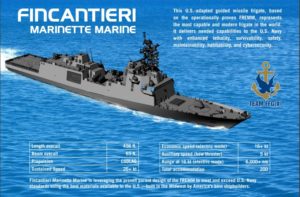Pushing up the decision by three months, the Navy on Thursday awarded Fincantieri’s Marinette Marine a $795 million detail design and construction (DD&C) contract for the FFG(X) guided-missile frigates over three rival bids.
The contract provides for delivery of up to 10 FFG(X) ships, post-delivery availability support, engineering and class services, crew familiarization, training equipment and provisioned item orders.

The frigate competition required “parent designs” to speed up the process of producing and delivering the vessels. Ficantieri offered a modified version of the Italian and French FREMM multipurpose frigate.
Five companies first participated in the initial $15 million conceptual design process: Fincantieri, Lockheed Martin [LMT], Austal USA, Huntington Ingalls Industries [HII], and General Dynamics’ Bath Iron Works [GD]. The award aimed to reduce risk in the program by allowing industry to mature designs faster to meet the Navy’s capability requirements (Defense Daily, Feb. 16, 2018).
However, last year Lockheed Martin dropped out of the frigate competition, ultimately leaving three losers in the final competition. The company had planned to compete with a version of its Freedom-variant LCS (Defense Daily, May 29, 2019).
HII never revealed its prospective design but was thought to offer a variant of its National Security Cutter; Austal USA used a variant of its Independence-variant LCS; and General Dynamics used a version of the Spanish F100 frigate.
The announcement explained the base contract includes the DD&C of the first FFG(X) ship and separately priced options for nine additional ships.
If all options are exercised, the contract value will rise to a total $5.6 billion, with work finished by May 2035.
Work will occur in several locations, primarily Marinette, Wis. (52 percent); Boston (10 percent); and Crozet, Va. (eight percent).
The announcement underscored this competition used a tradeoff process to determine the best proposal value using both price and non-price factors.
“The Navy made the best value determination by considering the relative importance of evaluation factors as set forth in the solicitation, where the non-price factors of design and design maturity and objective performance (to achieve warfighting capability) were approximately equal and each more important than remaining factors,” the announcement said.
The Navy expects to ultimately buy 20 total frigates as part of its plan for 52 small surface combatants, when combined with Littoral Combat Ships (LCSs). The frigates will feature a modified Raytheon Technologies [RTX] SPY-6 radar, Lockheed Martin [LMT] Aegis Combat System], and 32 vertical launch cells.
Previously, the Navy’s FY 2021 budget request documents expected the first vessel would be awarded in July at a cost of $1.28 billion while the second would cost $1.05 billion. It also pushed back the FFG(X) schedule to avoid moving too fast and having worse outcomes like in the case of the LCSs (Defense Daily, Feb. 11).
In 2019 the Navy planned to buy 1 ship in FY ’20, then two per year from FY ’21-’25 for 10 total over five years. Then this year, the Navy said it shifted plans to buy one each in FY ’21 and FY ’22 then two each in FY ’23 and FY ’24, before moving to three in FY ’25, totaling nine over five years.
Deputy Assistant Secretary of the Navy for Budget Rear Adm. Randy Crites told reporters during the budget request release the Navy is concerned about not repeating lessons learned with moving too fast on the LCS.
“As it is, we’ll have eight ships in construction before we deliver the first frigate in ’26,” Crites said in February.
The Navy plans to award the second frigate in 2021.
FY ’21 budget documents said the Navy expects construction on the first ship to start in July 2022 and then be delivered six years later in July 2026.